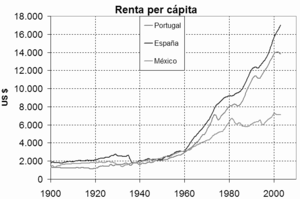Spanish miracle
The Spanish miracle (Spanish: El Milagro español, literally "The Spanish Miracle") was the name given to a broadly based economic boom in Spain from 1959 to 1974. It was brought to an end by the international oil and stagflation crises of the 1970s.

History
Initiation of the boom
The "economic miracle" was initiated by the reforms promoted by the so-called technocrats who, with Franco's approval, put in place policies developed in Spain. The technocrats, many of whom were members of Opus Dei, were a new breed of politicians who replaced the old falangist guard.[1] The implementation of these policies took the form of development plans (Spanish: Planes de desarrollo) and it was largely a success: Spain enjoyed the second highest growth rate in the world, only slightly behind Japan[2] and became the ninth largest economy in the world, just behind Canada. Spain joined the industrialised world, leaving behind the poverty and endemic functional underdevelopment it had experienced following the Napoleonic wars, the loss of most of its imperium in the 1820s and the civil wars of the 19th century because of the dynastic dispute for the crown.
Industrialization

The rapid economic expansion reinvigorated old industrial areas: the Basque Country and Ferrol northern coast (iron and steel, shipbuilding), and in and around Barcelona (machinery, textiles, cars and petrochemicals). It also drove an enormous expansion in refining, petrochemicals, chemicals and engineering. To help achieve rapid development, there was massive government investment through key state owned companies like the national industrial conglomerate Instituto Nacional de Industria, the mass market car company SEAT in Barcelona, the big steel plant of Ensidesa in Avilés and the shipbuilder Empresa Nacional Bazán. With heavy protection from foreign competition within the domestic Spanish market, these companies led the industrialisation of the country, restoring the prosperity of industrial areas like Barcelona and Bilbao and creating new industrial areas, most notably around Madrid. Although there was economic liberalisation in the period, key enterprises remained under state control.
Automotive industry
The automotive industry was one of the most powerful locomotoras (locomotives) of the Spanish Miracle: from 1958 to 1972 it grew at a yearly compound rate of 21.7%; in 1946 there were 72,000 private cars in Spain, in 1966 there were over 1 million.[4] This growth rate had no equal in the world. The icon of the desarrollo was the SEAT 600 car, produced by the Spanish company SEAT. More than 794,000 of them were made between 1957 and 1973, and if at the beginning of this period it was the first car for many Spanish working-class families, at its end it was the first second one for many more.
See also
- Economic miracle
- West German Wirtschaftswunder ("German economic miracle")
- Celtic Tiger
- Japanese post-war economic miracle
- Trente Glorieuses
- Instituto Nacional de Industria
- Pegaso
- SEAT
- Spain under Franco
References
- Jensen, Geoffrey. "Franco: Soldier, Commander, Dictator". Washington D.C.: Potomac Books, Inc., 2005. p. 110-111.
- Reuter, Tim (May 19, 2014). "Before China's Transformation, There Was The "Spanish Miracle"". Forbes. Retrieved December 30, 2017.
- El coche como símbolo del declive http://www.abc.es/hemeroteca/historico-14-11-2008/abc/Opinion/el-coche-como-simbolo-del-declive_911233353595.html
- J.L. García Ruiz, "Barreiros Diesel y el desarrolo de la automoción en España""ftp://ftp.funep.es/phe/hdt2003.pdf". External link in
|title=(help); Missing or empty|url=(help)ftp://ftp.funep.es/phe/hdt2003.pdf%5B%5D.
